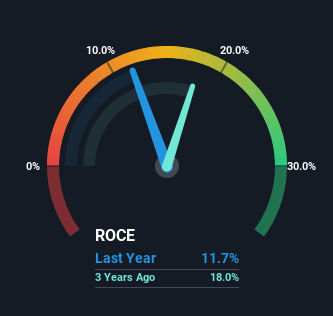Be Wary Of Chr. Hansen Holding (CPH:CHR) And Its Returns On Capital

Did you know there are some financial metrics that can provide clues of a potential multi-bagger? One common approach is to try and find a company with returns on capital employed (ROCE) that are increasing, in conjunction with a growing amount of capital employed. Ultimately, this demonstrates that it's a business that is reinvesting profits at increasing rates of return. However, after briefly looking over the numbers, we don't think Chr. Hansen Holding (CPH:CHR) has the makings of a multi-bagger going forward, but let's have a look at why that may be.
What Is Return On Capital Employed (ROCE)?
For those who don't know, ROCE is a measure of a company's yearly pre-tax profit (its return), relative to the capital employed in the business. The formula for this calculation on Chr. Hansen Holding is:
Return on Capital Employed = Earnings Before Interest and Tax (EBIT) ÷ (Total Assets - Current Liabilities)
0.12 = €359m ÷ (€3.4b - €362m) (Based on the trailing twelve months to August 2023).
Thus, Chr. Hansen Holding has an ROCE of 12%. By itself that's a normal return on capital and it's in line with the industry's average returns of 12%.
Check out our latest analysis for Chr. Hansen Holding

In the above chart we have measured Chr. Hansen Holding's prior ROCE against its prior performance, but the future is arguably more important. If you're interested, you can view the analysts predictions in our free report on analyst forecasts for the company.
What The Trend Of ROCE Can Tell Us
Unfortunately, the trend isn't great with ROCE falling from 21% five years ago, while capital employed has grown 102%. That being said, Chr. Hansen Holding raised some capital prior to their latest results being released, so that could partly explain the increase in capital employed. Chr. Hansen Holding probably hasn't received a full year of earnings yet from the new funds it raised, so these figures should be taken with a grain of salt.
Our Take On Chr. Hansen Holding's ROCE
Bringing it all together, while we're somewhat encouraged by Chr. Hansen Holding's reinvestment in its own business, we're aware that returns are shrinking. Unsurprisingly, the stock has only gained 4.3% over the last five years, which potentially indicates that investors are accounting for this going forward. As a result, if you're hunting for a multi-bagger, we think you'd have more luck elsewhere.
One more thing to note, we've identified 1 warning sign with Chr. Hansen Holding and understanding this should be part of your investment process.
For those who like to invest in solid companies, check out this free list of companies with solid balance sheets and high returns on equity.
New: AI Stock Screener & Alerts
Our new AI Stock Screener scans the market every day to uncover opportunities.
• Dividend Powerhouses (3%+ Yield)
• Undervalued Small Caps with Insider Buying
• High growth Tech and AI Companies
Or build your own from over 50 metrics.
Have feedback on this article? Concerned about the content? Get in touch with us directly. Alternatively, email editorial-team (at) simplywallst.com.
This article by Simply Wall St is general in nature. We provide commentary based on historical data and analyst forecasts only using an unbiased methodology and our articles are not intended to be financial advice. It does not constitute a recommendation to buy or sell any stock, and does not take account of your objectives, or your financial situation. We aim to bring you long-term focused analysis driven by fundamental data. Note that our analysis may not factor in the latest price-sensitive company announcements or qualitative material. Simply Wall St has no position in any stocks mentioned.
About CPSE:CHR
Chr. Hansen Holding
Chr. Hansen Holding A/S, a bioscience company, develops natural ingredient solutions for the food, nutritional, pharmaceutical, and agricultural industries in Europe, the Middle East, Africa, North America, Latin America, and the Asia Pacific.
Adequate balance sheet average dividend payer.

